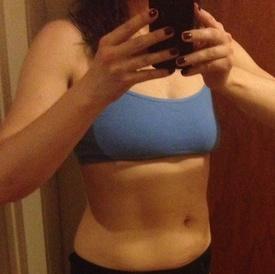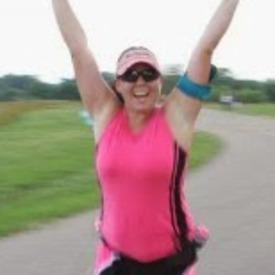Scott Jurek taught me to run uphill

likitisplit
Posts: 9,420 Member
Actually, I just had a great run yesterday. On my Thursday long run, I tried kicking back with my feet to increase my stride again (I've been working on increasing foot turnover). It was uncomfortable and exhausting and I gave it up after a mile. Then, during the last 1/4 mile, everything fell into place and it was like I was on springs. It was work, but it wasn't like I was pushing myself forward, it was like my legs were just transferring the forward motion as long as I was able to keep up with myself. When I checked Endomondo, that last bit stood out as being a lot faster.
So, when I did my two-mile run on Sunday (sigh, the last itsy bitsy run on my schedule), my body naturally went back to that stride as much as I could in my hilly neighborhood. I ran 11:30 the first mile and 12:30 the second - that's a full minute per mile faster than my last best time. Wow! And it felt really, really efficient even though I was probably putting in too much effort for an "easy run."
Also, I read Jurek's "Eat and Run." The way he says to run up hill is like the way you bike up hill: you put your bike into the smallest gear and keep pedaling at the same rate even though you're not moving as quickly. When you run up hill, you take small, fast steps so your legs are moving at the same rate but you're not expending any more effort trying to push yourself uphill.
So, when I did my two-mile run on Sunday (sigh, the last itsy bitsy run on my schedule), my body naturally went back to that stride as much as I could in my hilly neighborhood. I ran 11:30 the first mile and 12:30 the second - that's a full minute per mile faster than my last best time. Wow! And it felt really, really efficient even though I was probably putting in too much effort for an "easy run."
Also, I read Jurek's "Eat and Run." The way he says to run up hill is like the way you bike up hill: you put your bike into the smallest gear and keep pedaling at the same rate even though you're not moving as quickly. When you run up hill, you take small, fast steps so your legs are moving at the same rate but you're not expending any more effort trying to push yourself uphill.
0
Replies
-
I also put more force into my arm swing to help propel me uphill.0
-
I totally run with my arms the last half mile. It's amazing how much difference they make.0
-
I tried kicking back with my feet to increase my stride again (I've been working on increasing foot turnover).
Can you explain this? I want to drop a minute off my mile. LOL.0 -
You running turnover (or stride frequency) is how many steps you take in a minute. A shorter turnover means fast run times, and you use less energy and the impact on your feet is minimized.How to Increase Your Turnover Rate
Next time you’re running, do a quick test to figure out your own turnover rate: In a safe spot where you won’t fall or get hit by a car (ideally on a treadmill), record how many times your feet land on the ground in 15 seconds. Multiply this number by 4, and you’ve got your leg turnover per minute. (Note: You want to count impacts from both of your feet, not just one. If you prefer to count the number of impacts by just one foot, then double the figure you get after multiplying by 4.)
Well, what’d you come up with? If you’ve never consciously thought about this, then chances are you’re way under 180. That’s ok – so was I, and with a little practice, 180 steps per minute can become second nature. And you won’t believe what it can do for your running and resistance to injury.
Here’s how to get yourself running at 180 steps per minute:
Get on a treadmill.
Set it to a brisk but comfortable speed (running really slow is actually harder than fast with this).
Start running and line your steps up so that each time a second ticks, your third step impacts the ground.
For example, if your right foot lands when the clock shows one second (0:01), then it’ll be “left” then “right” before your left foot lands exactly when the clock hits 0:02. Then “right,” then “left” before your right foot hits on 0:03. And so on.
This is a lot easier than it sounds. Once you get into the rhythm, you’ll find that it’s pretty easy to keep it going (it just feels like you’re a cartoon character and your legs are spinning like wheels, and you’re wondering what other people must think).0 -
Olympic level athletes usually clock in at about 180 + strides per minute. Us people are usually around 160 (or should be - small quick steps cause less injury). I use the NHS Bridge program to help with this. It has you run to a beat.
However, I felt like I wasn't using my energy efficiently and needed to provide myself more forward motion - that was just a gut impression and if you ask experienced runners you'll get all sorts of opinions. So I started to push a bit through the end of my stride while keeping my feet landing under me. Once I got the hang of it, it was more exertion but there was no specific discomfort and it felt a lot smoother. A lot more like the "wheels spinning."
Also, rdulir, the guy on your ticker is over striding. Look at that heel strike! 0
0 -
Hey, thanks to both of you! I had not even been to think of turnover rate.0
-
I tried this today. My usual stride seems to be around 140. I picked it up to 160-ish and found it an easier run. It wasn't comfortable for a long stretch of time, though. Maybe it's something one has to get used to? However, my legs felt easier and in less discomfort. I'm going to keep practising it to see if it begins to feel more natural.
I'm not sure if I was pushing through the end of my stride.
Thanks, Varda!0 -
Increasing my cadence is one thing I've been working on since coming back from tendonitis. Shorter strides and higher leg turnover seem to helping to keep the pain from coming back like before. And using my arms more too. I find that if I speed up my arms, my legs will naturally follow the pace without thinking about it. Lately I've been able to keep a 5:30/km pace without getting tired or getting my heartrate up very high.0
This discussion has been closed.



